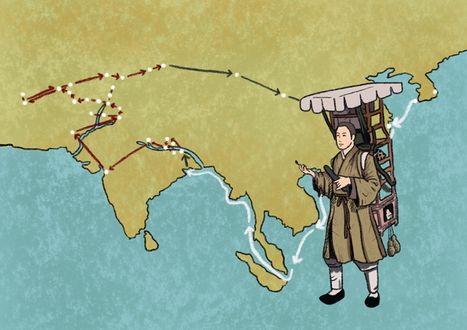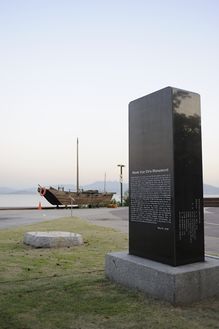"Hyecho's Trip to India"의 두 판 사이의 차이
| 16번째 줄: | 16번째 줄: | ||
<gallery mode=packed heights=220px> | <gallery mode=packed heights=220px> | ||
File:혜초의 왕오천축국전_일러스트.jpg|Drawing of Hyecho | File:혜초의 왕오천축국전_일러스트.jpg|Drawing of Hyecho | ||
| − | |||
File:4-1.혜초기념비-_GSC9718.jpg|Hyecho Memorial Monument (Pyeongtaek, Gyeonggi-do) | File:4-1.혜초기념비-_GSC9718.jpg|Hyecho Memorial Monument (Pyeongtaek, Gyeonggi-do) | ||
</gallery> | </gallery> | ||
2017년 11월 25일 (토) 11:22 판
Hyecho, an 8th century Korean Buddhist monk, wrote a travelogue entitled “Journey to the Five Nations of India” after traveling to five regions of northern and eastern India. He probably left Tang China by sea in 723 CE and returned over land after four years. Hyecho studied Tantric Buddhism under Master Vajrabodhi in China before he made the trip. His book was found by French explorer P. Pelliot in the Dunhuang Caves in 1908.
His travelogue, written in literary Chinese, chronicles his pilgrimage to sacred places of Buddha’s birth, death and mission in India and records his observations on the various regions and countries he traveled through on his return trip to China. Hyecho first visited Kushinagara, where Buddha died, then proceeded to Varanasi, where Buddha delivered his first sermon to five bhikkhus after his great awakening. Hyecho also visited Rajagrha, Vulture Mountain, and Bodhgaya where Buddha attained the awakening, and Lumbini where Buddha was born.
On his way back to China, Hyecho visited Kashmir, Gandhara in what is now Pakistan, Peshawar and Gilgit in what is now Afghanistan. He traveled through the Silk Road linking China to Central Asia, the Parmir Plateau, Kashgar and an oasis town at the edge of the Taklimakan Desert. His travelogue ended there with the last remaining entry around November 727. Two-thirds of his travelogue is lost, leaving only one volume out of the original three.
In his travelogue, Hyecho recorded such strange customs as people living naked, brothers sharing one common wife and men marrying their mothers and sisters. Hyecho’s book is the only written record of northern India and Central Asia in the 8th century. He also observed the military strength of the countries he was passing. His reference to the Arabs in the book indicates the extent of their advancement into India. He described the westward influence of the Han Chinese into Central Asian countries along the route of his return trip.
Hyecho also touched on the practices of Mahayana and Hinayana Buddhism in the countries, while visiting all the eight sacred places of Buddhism. Also he left detailed description of the regional variations in food, clothing, customs, products and weather.
Hyecho’s travelogue is one of the four famous travel books along with the Travels of Marco Polo, the Travels of Ibn Battuta, and the Travels of Friar Odoric; it predates the other three by about 500 years.
Related Articles
- [[]]

